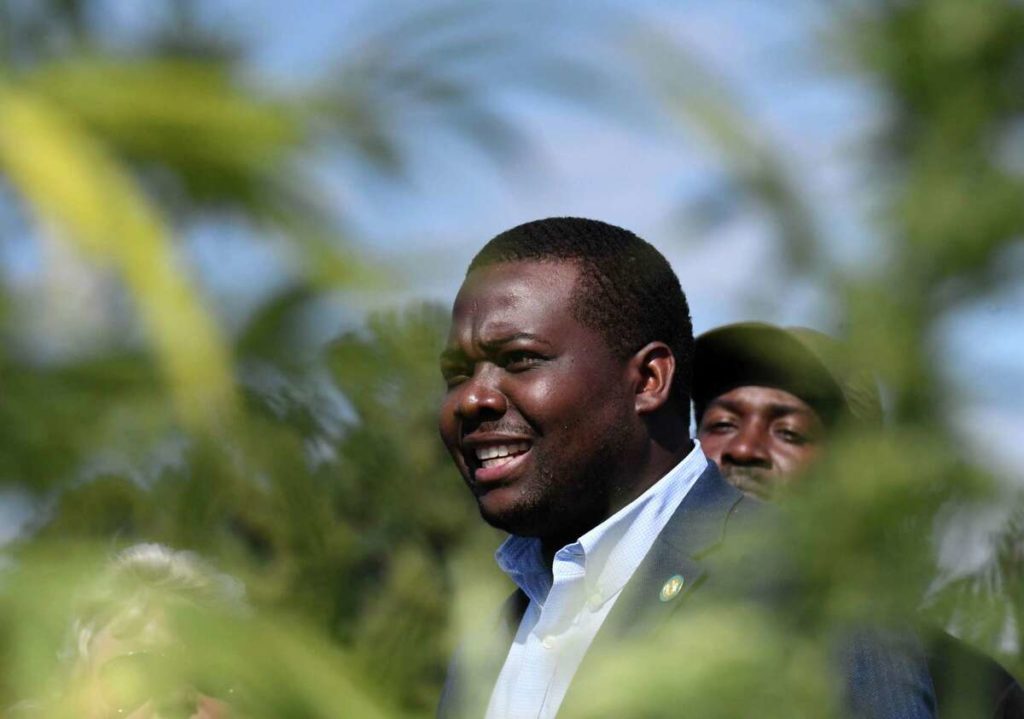Chris Alexander, executive director of the state Office of Cannabis Management, spoke during a new conference at Claudine Field Apothecary, a cannabis farm in Columbia County, in October.
The State Liquor Authority and the Office of Cannabis Management on the surface seem like similar agencies: They both regulate the manufacture, distribution and sale within the nation’s fourth-largest state of an intoxicant that is mostly consumed recreationally. (Yes, there are medical uses for marijuana, but less than 1 percent of New Yorkers have been prescribed it, according to the Marijuana Police Project.)
And while the SLA oversees a vast, 90-year-old, multibillion-dollar industry with 50,000 current licenses for making or selling alcohol and processed more than 80,000 license and permit transactions in 2021, OCM has been given far more resources for an industry that is 16 months old and so far has issued only 66 licenses for cannabis dispensaries.
OCM was established in March 2021 with the passage of the Marijuana Regulation and Taxation Act. Staffing began to ramp up that fall. In October of 2021 the agency had 14 employees; there were 135 by the end of 2022 and 150 as of this week, said Chris Alexander, who was appointed OCM’s executive director by Gov. Kathy Hochul in September 2021. A former executive with a multistate cannabis company, Alexander previously was associate counsel for the state Senate and principal architect of the legalization bill.
OCM’s budget for fiscal year 2022-23 was $46 million, rising to $62 million in the proposed 2023-24 budget, state figures show.
In contrast, the SLA’s next proposed budget is $16.7 million, only 27 percent of OCM’s, for roughly the same number of employees (153 at the SLA vs. 150, though Alexander said he expects to hire another 50 by year’s end, moving later toward 300).
And OCM’s staffers are highly paid: 46 employees, nearly a third of its workforce, make more than $100,000 annually, according to the state comptroller’s office, compared to 19 earning at least $100,000 at the SLA. Further, while Alexander and his counterpart at the SLA, Vincent Bradley, make roughly the same, at $196,000 and $200,000, respectively, OCM’s board chair, Tremaine S. Wright, is paid $208,000, records show. (The four other members of the Cannabis Control Board are unpaid.)
All of this raises a few questions, starting with: Why does a government agency regulating a nascent industry that likely affects less than quarter of the state’s population receive such lavish resources?
In short, Alexander said, because of the massive tasks it’s been assigned and the imperative to do it right, factoring in fairness and equity for participating businesses and public safety for consumers. OCM is creating the framework for an entirely new sector of the state economy.
“There is no … analogue directly for what we have to do as a regulatory body,” he said during a phone interview Wednesday night. A familiar refrain of his is contained in OCM’s 2022 annual report: “We have, as I’ve said throughout the year, built the plane while flying it.”
OCM’s mandate is indeed daunting: Write regulations for the growth, processing, distribution and sale of cannabis products; define and oversee the rules for related businesses, including delivery services and on-site-consumption locations (aka cannabis cafes); and establish quality standards that will be maintained by labs contracted to test cannabis products, which all must originate from crops grown within New York.
“It’s (like) we have an in-house FDA,” Alexander said, referring to the federal Food and Drug Administration.
Central to discussion of the effects of legalized cannabis is the potential market and resulting tax revenue.
A 2018 projection by Scott M. Stringer, then the comptroller of New York City, said the market for legal cannabis in the state could quickly rise to $3 billion in annual sales, realizing $436 million for the state in taxes.
Alexander this week called that estimate conservative, saying he thought $5 billion was more realistic after a few years, perhaps climbing to $15 billion.
“That’s at the end of a mature market, when we get there — stores open, everybody participating,” he said.
The $15 billion figure seems absurd. California, with more than double the population of New York, took four years after cannabis legalization to reach $5 billion in annual sales, according to Cannabis Business Times.
And despite Alexander’s confidence that legal cannabis will prompt some people to choose it over alcohol and generate a significantly larger number of users, studies don’t yet bear out either claim.
A 2021 report by the Cato Institute concluded that there is “no clear relationship between marijuana legalization and alcohol use.”
The same report shows that five years after legalization in Colorado, cannabis consumption climbed from 15 percent to 25 percent of the population using it within the prior year, but that pales in comparison to the 55 percent of Americans who said they drank alcohol within the past month, according to federal statistics.
The belief that New York’s cannabis market could be triple the size of California’s does not seems factually defensible. But legalized sales have arrived. And politicians have been persuaded to give the supervising agency the resources that have long been denied the SLA, which brings in $76 million in licensing fees and disciplinary fines but keeps only $16 million for its operations.
Here’s the difference: Although it’s been widely recognized for more than 40 years that the entire book of Alcoholic Beverage Control laws in New York needs to be thrown out and written anew, no one has been willing to expend the political capital to get it done. Legalized cannabis sales, promising a half-billion-dollar tax windfall within a few years, are the shiny new thing drawing all of the attention.
That’s politics for you.
H/T: www.timesunion.com



